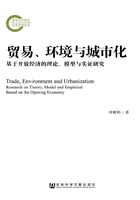
Abstract
Nowadays, the problem of trade, environment and urbanization is a challenging scientific hot issue that faced equally by all nations. On the one hand, trade liberalization brings an unprecedented impact on our living environment as well as boosts the economic development, promotes technology progress and improves benefits. The issues of environment increasingly attract worldwide attention and become one of the focuses in international economy and political field. On the other hand, trade and urbanization are two important issues in the process of sustainable development. The coordinated development of trade, environment and urbanization is highly valued by governments and relevant institutions, as people pay more attention to global warming and request the reduction of greenhouse gas emission. At the present, China plays a more and more important role in international trades, and its high-speed development of urbanization has got worldwide attention, which also makes China's environmental problems be much concerned about by the international organizations. “Win-win strategy of opening-up”, “Healthy urbanization”and“Construction of resource-conserving and environment-friendly society”are key strategies emphasized by“the Eleventh Five-Year Plan”, and“Optimization pattern, regional coordinating development promotion and healthy development of urbanization”, “Green development, building resource-conserving and environment-friendly society”,“Improve opening-up level and win-win”have become three strategic development directions of“the Twelfth Five-Year Plan”, which suggests that under the influence of world economy trends, how to promote regional coordination, develop healthy urbanization, construct ecological civilization and promote the development of recycle economy at the same time are becoming a key problem that must be solved in China's long-term planning. Accordingly, this paper put trade, environment and urbanization into a analytical framework, to analyze their interaction effect, to build transmission mechanism and endogenous growth relationship model, as well as to evaluate their coordinating development and to simulate scenario. We put forward the corresponding suggestions for the coordinating development, which undoubtedly has significant theoretical and practice value.
The book keeps on the principle of combining normative analysis and empirical research, and the study thought line is from the phenomenon description to theoretical analysis, then to construct models contracting and empirical study, last to policy suggestions.
Firstly, with the description of the interactive effect of trade, environment and urbanization under the open economy, the book uses static equilibrium, market equilibrium and optimization method to analyze the relationship between trade, environment and urbanization.
Secondly, with interpreting the concept of transmission mechanism and referring to the interactive effect analyzing results, the book employs comparison equilibrium analysis method to analyzing the different conductive processes using trade, environment and urbanization as tool targets respectively. And then, the book uses the simultaneous equations modeling thought to construct the transmission mechanism model of opening economy trade, environment and urbanization.
Thirdly, the book takes the advantages of the opening economy endogenous growth model which contain environment element, the opening economy urbanization model and the relationship model of urbanization and economic growth to set up the endogenous growth relationship model between opening economy trade, environment and urbanization through market equilibrium and optimization analysis.
Fourthly, the book uses the synergetic technology to build the coordinated development evaluation model of opening economy trade, environment and urbanization. Furthermore, the book applies scenario analysis method to establish scenario simulation model.
Fifthly, the book employs the above analyzing framework and theories, based on time series and panel data, to use time series metering method, panel simultaneous equations, panel dynamic method, collaborative analysis technology and scene analysis method respectively to make empirical test on the interactive relationship of trade, environment and urbanization, their transmission mechanism, endogenous growth relationship, coordinated growth and scene development of Yangtze River delta(16 cities). First of all, the book made on the timing system analysis technology of VAR model to inspect the long-term equilibrium relationship, Granger causal relationship and dynamic influence effects of trade, environment and urbanization between 1990-2009 in Yangtze River delta(16 cities). Then, the book made use of panel measuring model and panel simultaneous equations estimation method to investigate the long-term equilibrium relationship and transmission mechanism between trade, environment and urbanization. And then, next, the book uses panel measuring model, panel FMOLS and DOLS estimation method to examine the endogenous growth relationship of trade, environment and urbanization for then during 1990-2009. At last, the book evaluates and classifies the coordination situations, and bases on scenario analysis method to simulate them. According to that, the book summarizes the conclusions and puts forward the policies and proposals for coordinated development in Yangtze River delta.
Lastly, in order to make the theory to normative practice, the book chooses U. S. A. and EU as the most typical objects to compare their implemented policies. By summarizing the useful experiences and measures which they aim to coordinate the relationships between urbanization and environment, international trade and urbanization, international trade and environment, the book expects to give China policy suggestions to contribute to the coordinated development of the relationships among international trade, environment and urbanization.